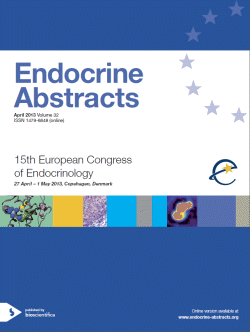Searchable abstracts of presentations at key conferences in endocrinology
ea0032mte1 | (1) | ECE2013
What systems biology can do for endocrine research?
Systems biology views and studies the biological systems in the context of complex interactions between their building blocks and processes. Given its multi-level complexity, metabolic syndrome (MetS) makes a strong case for adopting the systems biology approach. Despite many MetS traits being highly heritable, it is becoming evident that the genetic contribution to these traits is mediated via genegene and gene environment interactions across several spatial and t...
ea0032mte3 | (1) | ECE2013
Insulin therapy
Insulin replacement therapy is essential for anyone with type 1 diabetes. Most patients with gestational or type 2 diabetes may also require insulin. The goals of insulin therapy are: to achieve optimal glycemic control without causing hypoglycemia or excessive weight gain and to minimize the impact on lifestyle. The therapeutic goals should be individualized according to patients age, disease duration, complications, comorbidities, lifestyle, and expected survival.<...
ea0032mte5 | (1) | ECE2013
Current guidelines for the classification of net
Neuroendocrine neoplasms (NENs) are a variety of neoplastic lesions distributed in most organs and apparata. The current World Health Organization (WHO 2010) introduced tumor grading (G1G3) and tumour node metastasis (TNM) staging for class definition. The proposed grading system defines three classes (G1G3) according to both mitotic count and Ki67 index. Three classes were defined as WHO class 1, neuroendocrine tumor (NET), G1; WHO class 2, NET G2 and WHO class 3,...
ea0032mte6 | (1) | ECE2013
New immunotherapy approaches for Graves’ orbitopathy
The role of B-cell in human autoimmune disease have recently been emphasized due to the therapeutic benefit of B-cell depleting therapies. B cells are involved in the production of autoantibodies, CD4+T-cell activation and control of T-cell function and inflammation, through cytokine production. Although autoantibodies alone may not initiate autoimmune disease, their relationship with the disease course suggests that they are a key factor contributing to the mechanisms of dise...
ea0032mte13 | (1) | ECE2013
Hypogonadotropic hypogonadism
Patients with congenital hypogonadotropic hypogonadism (cHH; also referred to as idiopathic HH) have inadequately low gonadotropin and sex steroid levels for age without an underlying organic or functional cause. The combination of cHH and deficient sense of smell is called Kallmann syndrome (KS; incidence 1:30 000 in Finnish boys, and 1:125 000 in girls), which is due to misrouting of primitive GnRH neurons in utero from the olfactory placodal area to the developing ...
ea0032mte16 | (1) | ECE2013
Diabetic foot disease for endocrinologists
Foot complications are common in people with diabetes. As the incidence of diabetes continues to rise and an increasingly aged population accrue substantial numbers of non-reversible, chronic disease processes, the burden of diabetic foot disease can only grow. Ulceration and amputation are associated with high mortality, reduced quality of life and significant financial cost to both patient and health care provider.The management of diabetic foot diseas...




